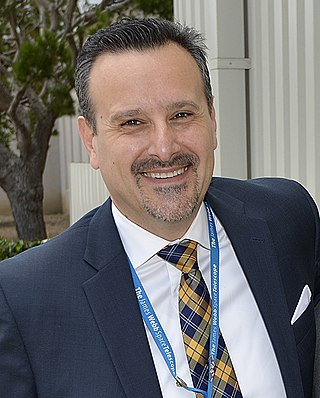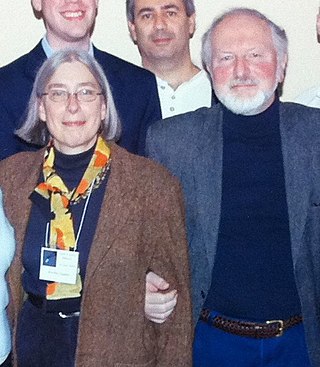
The Hubble Space Telescope is a space telescope that was launched into low Earth orbit in 1990 and remains in operation. It was not the first space telescope, but it is one of the largest and most versatile, renowned both as a vital research tool and as a public relations boon for astronomy. The Hubble telescope is named after astronomer Edwin Hubble and is one of NASA's Great Observatories. The Space Telescope Science Institute (STScI) selects Hubble's targets and processes the resulting data, while the Goddard Space Flight Center (GSFC) controls the spacecraft.

Sandra Moore Faber is an American astrophysicist known for her research on the evolution of galaxies. She is the University Professor of Astronomy and Astrophysics at the University of California, Santa Cruz, and works at the Lick Observatory. She has made discoveries linking the brightness of galaxies to the speed of stars within them and was the co-discoverer of the Faber–Jackson relation. Faber was also instrumental in designing the Keck telescopes in Hawaii.

The Space Telescope Science Institute (STScI) is the science operations center for the Hubble Space Telescope (HST), science operations and mission operations center for the James Webb Space Telescope (JWST), and science operations center for the Nancy Grace Roman Space Telescope. STScI was established in 1981 as a community-based science center that is operated for NASA by the Association of Universities for Research in Astronomy (AURA). STScI's offices are located on the Johns Hopkins University Homewood Campus and in the Rotunda building in Baltimore, Maryland.

The Hubble Deep Field (HDF) is an image of a small region in the constellation Ursa Major, constructed from a series of observations by the Hubble Space Telescope. It covers an area about 2.6 arcminutes on a side, about one 24-millionth of the whole sky, which is equivalent in angular size to a tennis ball at a distance of 100 metres. The image was assembled from 342 separate exposures taken with the Space Telescope's Wide Field and Planetary Camera 2 over ten consecutive days between December 18 and 28, 1995.

Vesto Melvin Slipher was an American astronomer who performed the first measurements of radial velocities for galaxies. He was the first to discover that distant galaxies are redshifted, thus providing the first empirical basis for the expansion of the universe. He was also the first to relate these redshifts to velocity.

The Hubble Deep Field South is a composite of several hundred individual images taken using the Hubble Space Telescope's Wide Field and Planetary Camera 2 over 10 days in September and October 1998. It followed the great success of the original Hubble Deep Field in facilitating the study of extremely distant galaxies in early stages of their evolution. While the WFPC2 took very deep optical images, nearby fields were simultaneously imaged by the Space Telescope Imaging Spectrograph (STIS) and the Near Infrared Camera and Multi-Object Spectrometer (NICMOS).
Hubble search for transition comets was a study involving amateur astronomers and the use of the Hubble Space Telescope, one of only six studies involving amateur astronomers approved by NASA.
Amy J. Barger is an American astronomer and Henrietta Leavitt Professor of Astronomy at the University of Wisconsin–Madison. She is considered a pioneer in combining data from multiple telescopes to monitor multiple wavelengths and in discovering distant galaxies and supermassive black holes, which are outside of the visible spectrum. Barger is an active member of the International Astronomical Union.

Alberto Conti, is an astrophysicist and the Vice President and General Manager of the Civil Space Strategic Business Unit (SBU) at Ball Aerospace. He is one of the creators of the GoogleSky concept, of the idea of astronomical outreach at South by SouthWest 2013 and of the James Webb Space Telescope iBook. He is also the Executive Producer of the Emmy Winning CNN Films The Hunt for Planet B.

A1689-zD1 is a galaxy in the Virgo constellation. It was a candidate for the most distant and therefore earliest-observed galaxy discovered as of February 2008, based on a photometric redshift.

Martha Patricia Haynes is an American astronomer who specializes in radio astronomy and extragalactic astronomy. She is the distinguished professor of arts and sciences in astronomy at Cornell University. She has been on a number of high-level committees within the US and International Astronomical Community, including advisory committee for the Division of Engineering and Physical Sciences of the National Academies (2003–2008) and Astronomy and Astrophysics Decadal Review. She was a vice-president of the executive committee of the International Astronomical Union from 2006–2012, and was on the board of trustees of Associated Universities Inc from 1994 until 2016, serving two terms as board chair and one year as interim president.
Marc Postman is an American astronomer at the Space Telescope Science Institute in Baltimore, Maryland, United States. His research interests include observational studies of the formation and evolution of galaxies and large scale structure in the universe. His work focuses on determining, observationally, the relationships between galaxy-scale phenomena and the surrounding large-scale environment and matter distribution. His recent research includes characterizing the properties of brightest cluster galaxies and placing new constraints on the cosmic optical background.

Rodger Evans Doxsey was an American physicist and astronomer who made major contributions to the scientific and operational success of NASA's Hubble Space Telescope (HST). He joined the HST Project at the Space Telescope Science Institute (STScI), in Baltimore, Maryland, in 1981, and was head of the Hubble Missions Office at his death.

Charles Mattias ("Matt") Mountain is currently the President of the Association of Universities for Research in Astronomy (AURA) which designs, builds, and operates telescopes and observatories for the National Science Foundation (NSF) and the National Aeronautics and Space Administration (NASA). AURA's NASA center is the Space Telescope Science Institute (STScI), responsible for the science mission for the Hubble Space Telescope, the science and operations for the James Webb Space Telescope, and the MAST data archive. AURA's NSF centers are Gemini Observatory, the National Optical Astronomy Observatory (NOAO), and the National Solar Observatory (NSO). Dr. Mountain and AURA are also responsible for the NSF construction projects: the Daniel K. Inouye Solar Telescope (DKIST) on Haleakalā, Hawaii and the Large Synoptic Survey Telescope (LSST) on Cerro Pachón in Chile.

Laura Ferrarese is a researcher in space science at the National Research Council of Canada. Her primary work has been performed using data from the Hubble Space Telescope and the Canada-France-Hawaii Telescope.
George Kildare Miley is an Irish-Dutch astronomer. He holds a professorship at Leiden University, where he served as director of Leiden Observatory from 1996 to 2003.

GN-z11 is a high-redshift galaxy found in the constellation Ursa Major. It was among the farthest known galaxies from Earth ever discovered. The 2015 discovery was published in a 2016 paper headed by Pascal Oesch and Gabriel Brammer. Up until the discovery of JADES-GS-z13-0 in 2022 by the James Webb Space Telescope, GN-z11 was the oldest and most distant known galaxy yet identified in the observable universe, having a spectroscopic redshift of z = 10.957, which corresponds to a proper distance of approximately 32 billion light-years.
The Mikulski Archive for Space Telescopes (MAST) is an astronomical data archive. The archive brings together data from the visible, ultraviolet, and near-infrared wavelength regimes. The NASA funded project is located at the Space Telescope Science Institute (STScI) in Baltimore, Maryland and is one of the largest astronomical databases in the world.
Daniela Calzetti is an Italian-American astronomer known for her research on cosmic dust, star formation, and galaxy formation and evolution, and in particular for the Calzetti dust extinction law, an estimate for how much information about distant galaxies has been obscured by cosmic dust. She is a professor of astronomy and head of the astronomy department at the University of Massachusetts Amherst, and principal investigator of the Legacy ExtraGalactic Ultraviolet Survey project of the Hubble Space Telescope.

The Peekaboo Galaxy is an irregular compact blue dwarf galaxy in the constellation Hydra. The galaxy is relatively small, at about 1,200 light-years across; and nearby, at a distance of about 22 million light-years from Earth. The Peekaboo Galaxy is considered one of the most metal-poor, least chemically enriched, and seemingly primordial, galaxies known.














